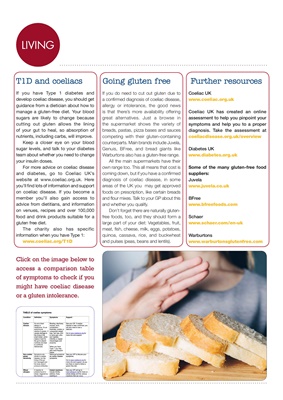
LIVINGLIVING
If you have Type 1 diabetes and
develop coeliac disease, you should get
guidance from a dietician about how to
manage a gluten-free diet. Your blood
sugars are likely to change because
cutting out gluten allows the lining
of your gut to heal, so absorption of
nutrients, including carbs, will improve.
Keep a closer eye on your blood
sugar levels, and talk to your diabetes
team about whether you need to change
your insulin doses.
For more advice on coeliac disease
and diabetes, go to Coeliac UK's
website at www.coeliac.org.uk. Here
you'll find lots of information and support
on coeliac disease. If you become a
member you'll also gain access to
advice from dietitians, and information
on venues, recipes and over 100,000
food and drink products suitable for a
gluten free diet.
The charity also has specific
information when you have Type 1:
www.coeliac.org/t1d
Coeliac UK
www.coeliac.org.uk
Coeliac UK has created an online
assessment to help you pinpoint your
symptoms and help you to a proper
diagnosis. Take the assessment at
coeliacdisease.org.uk/overview
Diabetes UK
www.diabetes.org.uk
Some of the many gluten-free food
suppliers:
Juvela
www.juvela.co.uk
BFree
www.bfreefoods.com
Schaer
www.schaer.com/en-uk
Warburtons
www.warburtonsglutenfree.com
If you do need to cut out gluten due to
a confirmed diagnosis of coeliac disease,
allergy or intolerance, the good news
is that there's more availability offering
great alternatives. Just a browse in
the supermarket shows the variety of
breads, pastas, pizza bases and sauces
competing with their gluten-containing
counterparts. Main brands include Juvela,
Genuis, BFree, and bread giants like
Warburtons also has a gluten-free range.
All the main supermarkets have their
own range too. This all means that cost is
coming down, but if you have a confirmed
diagnosis of coeliac disease, in some
areas of the UK you may get approved
foods on prescription, like certain breads
and flour mixes. Talk to your GP about this
and whether you qualify.
Don't forget there are naturally glutenfree
foods, too, and they should form a
large part of your diet: Vegetables, fruit,
meat, fish, cheese, milk, eggs, potatoes,
quinoa, cassava, rice, and buckwheat
and pulses (peas, beans and lentils).
T1D and coeliacs Going gluten free Further resources
Click on the image below to
access a comparison table
of symptoms to check if you
might have coeliac disease
or a gluten intolerance.